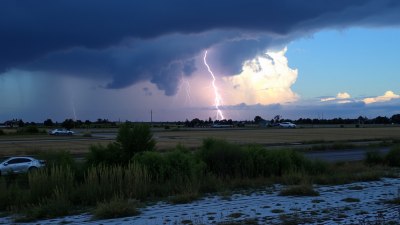The Mystery of Why the Sky Is Blue and Not a More Fun Color
Explore the science behind why the sky is blue and its implications for color perception.

This image was created with the assistance of Freepik
The sky is a vibrant blue color most of the time, and this phenomenon has intrigued humans for centuries. Children often ponder why the sky isn't a more 'fun' color, such as pink, green, or even neon colors. Understanding why the sky is blue requires a dive into atmospheric science, light physics, and the characteristics of human vision. In this article, we'll explore the reasons behind the blue sky, investigate the intricacies of Rayleigh scattering, and consider the cultural implications and perceptions of color.
The primary reason the sky appears blue lies in how sunlight interacts with the atmosphere. Sunlight, though it appears white to our eyes, is actually made up of a spectrum of colors. Each of these colors has different wavelengths. For instance, violet light has a shorter wavelength, while red light has a longer wavelength. When sunlight enters Earth's atmosphere, it collides with molecules in the air. This interaction results in scattering, a process where light changes direction as it hits particles.
Rayleigh scattering is the name given to this scattering of light by particles that are much smaller than the wavelength of light. In simple terms, shorter wavelengths of light (like blue and violet) are scattered more than longer wavelengths (like red and yellow). Although violet light is scattered even more than blue light, our eyes are more sensitive to blue, and some of the violet light is absorbed by the ozone layer. This combination results in a predominately blue sky.
Consider standing outdoors on a clear day and looking up. The deeper blue color seen directly overhead can be attributed to the angle and distance the sunlight has traveled through the atmosphere. During sunrise or sunset, the sun's rays have to pass through a greater thickness of the atmosphere, causing more scattering of the shorter wavelengths. Consequently, the rays that reach your eyes are predominantly the longer wavelengths, resulting in splendid reds, oranges, and pinks during these times. This beautiful transformation from blue to warm hues draws attention to the dynamic play of light and color in the sky.
Historical Perspectives on Sky Color
Historically, the question of why the sky appears blue has fascinated philosophers and scientists alike. Ancient Greek philosophers such as Aristotle wrote about the sky's color but didn’t possess the scientific framework we have today. Aristotle proposed that the color of the sky was due to the presence of 'aether,' a fifth element that filled the universe and was associated with the heavens. This concept worked for centuries until more significant scientific advances opened paths to modern understanding.
In the 19th century, scientists like John William Strutt, also known as Lord Rayleigh, conducted experiments that laid the foundation for our understanding of light scattering. This research eventually led to the discovery of Rayleigh scattering, formalizing the idea that particles in the atmosphere could scatter light and affect color perception. As science evolved, so did the analysis of light interactions and atmospheric conditions.
Scientific Investigation: How Do We Measure Sky Color?
To answer the question of sky color, scientists utilize various tools and methodologies. Spectrometers are commonly used to separate light into its constituent colors, allowing researchers to analyze specific wavelengths present in the atmosphere. By measuring the amount of scattered light at different angles, it becomes possible to model how light behaves under different atmospheric conditions.
Furthermore, modern technology, such as satellites equipped with sensors, provides data on sky color across different regions of the Earth and variations over time. These systems allow scientists to monitor changes in the atmosphere, including pollution levels, cloud cover, and other variables that may affect color perception. Such investigations contribute to a more profound understanding of atmospheric dynamics and help model climate change impacts.
Cultural Perceptions and the Psychology of Color
Beyond the scientific explanations, the color of the sky has cultural and psychological implications. In many societies, the color blue symbolizes calmness, peace, and serenity. Studies suggest that exposure to blue light may even have psychological benefits by promoting relaxation and reducing stress. Artists have long drawn inspiration from the sky, using its color palette to convey emotions and set the mood in paintings and literature.
Interestingly, colors can evoke different responses based on cultural context. For example, in some cultures, blue represents sadness or loss, while in others, it may signify loyalty and trust. The ubiquitous presence of blue in nature, particularly in the sky and oceans, leads to a collective association with tranquility in many people’s minds. On the other hand, colors not typically associated with the sky, such as green or yellow, could evoke more playful or adventurous feelings, presenting an alternative lens through which to view the world.
The Future of Sky Color Research
As climate change progresses, our understanding of the atmosphere continues to evolve. Increased levels of pollutants and greenhouse gases can dramatically alter the light scattering processes and the resulting hues we observe in the sky. Research is focused not just on how these changes might affect sky color but on the broader implications for weather patterns and human health. For instance, cities with high levels of air pollution may witness a shift in the color of the sky toward dull grays and browns, a phenomenon often described as “smog.”
Future generations will likely witness further changes in atmospheric color due to environmental changes and urbanization. Scientists are developing models to track how various factors influence the colors of the sky and their implications for ecosystems and human health. Understanding how these alterations might affect our perception of beauty and well-being is an ongoing area of research.
Embracing the Blue Sky
The mystery of why the sky is blue presents a fascinating interplay between physics, perception, and culture. While we may yearn for the sky to be painted in more vibrant or varied colors, the science behind its blue hue connects us to the delicate balance of our atmosphere. The ethereal beauty of a blue sky is a reminder of the Earth's unique environment and the complex systems holding it together.
As we continue to uncover the layers of atmospheric phenomena, one fact remains clear: the blue sky is more than just a background to our lives—it represents a constant reminder of the scientific wonders surrounding us. The next time you look up and admire the azure expanse overhead, remember the journey of light that is responsible for that color and consider how vital it is for our well-being.











